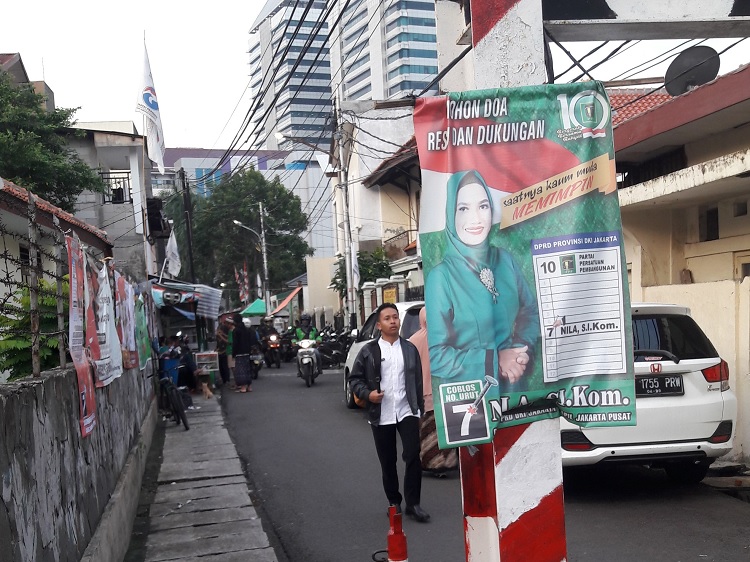Ella S Prihatini
When Indonesians go to the polls in April 2019, they will find an unprecedented number of female candidates on the ballot paper for the DPR (House of Representatives). Just over 40 per cent of all candidates will be women, and many more will be contesting seats at the provincial and district level. The nomination of so many female candidates has been linked to the stricter sanctions imposed by the KPU (Electoral Commission) for political parties’ non-compliance with Indonesia’s gender quota, which stipulates that parties must nominate a minimum of 30 per cent of female candidates or face disqualification. But while exceeding the 30 per cent benchmark by 10 per cent may look like a remarkable achievement, the experience from previous elections suggests that it is highly unlikely most of these candidates will actually get elected in April.
Since the introduction of the gender quota in 2004, the number of female legislative candidates in Indonesia has indeed increased steadily from 32 per cent in 2004 and over 35 per cent in 2009 to 37 per cent in 2014. However, the winning rate for these women – the number of women who got elected divided by the number of female candidates – has been rather low (Table 1). In 2014, for example, competing for 560 DPR seats were 2467 women out of 6607 total candidates. Just 97 women were elected.
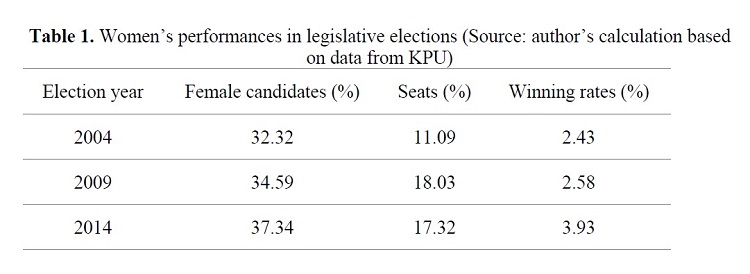
Some scholars attribute this slow progress to the attitudes of political parties who are not genuinely committed to nominating winning female candidates. With their mostly male-dominated leadership boards, political parties are not doing enough to nurture promising female aspirants. According to a study by elections watchdog Perludem, the majority of parties participating in the 2019 elections have also not been transparent with the public about their selection processes for candidates. This ‘black box’ of political recruitment tends to result in the nomination of women who have good connections or direct family ties to one of Indonesia’s many political dynasties, but who lack the campaign skills to win the race. Though the financial clout that comes with membership in a political dynasty helped several of these candidates over the line in the last elections, many others failed.
At the same time, those women who make it through the recruitment process without being the wife, sister or daughter of a prominent male politician often struggle because they find it difficult to mobilise the funds needed to first secure the nomination and then run a lengthy election campaign. Activists and observers therefore argue that women’s lesser access to material resources is a serious impediment to achieving gender equality in parliament.
Party officials acknowledge the problems associated with the high cost of campaigning, but also attribute female candidates’ poor success rate to women themselves. An official from PAN (the National Mandate Party), for example, told me fewer and fewer women are willing to invest in a nomination to run for parliament in the first place. This is partly due to the open list proportional representation system which has created huge uncertainty for candidates. Under this system, a person ranked anywhere on a party list can win a seat in a given electorate as long as they receive the most votes out of their party’s candidates. In 2014, this led to a massive increase in vote buying and other forms of money politics, putting women with fewer resources on the back foot.
A Golkar party representative echoed this view, asserting that ‘our party supports the legislated gender quotas, but the problem now is very few women are interested in participating in politics. For 2019, we can only nominate 37 per cent female candidates because this is the number of highly qualified women that we can find who are willing to run.’ Another Golkar MP agreed, saying that ‘women are demanding a 30 per cent quota, pushing for affirmative action so that more women can participate in politics. But the reality we have is far from this. Women’s interest in running is just low and not as great as it needs to be to meet their demands for a minimum gender quota of 30 per cent.’
Both politicians and women’s rights activists also advance the view that ever-increasing campaign costs are dampening both the public’s euphoria and women’s interest in participating as legislative candidates. Veteran women’s rights advocate Nursyahbani Katjasungkana claims soaring campaign costs have a particularly detrimental impact on activists who run for a parliamentary seat. ‘In 2014, even a renowned activist, who was also an incumbent, told me that she had spent 2 billion rupiah (A$186,000) on her campaign and still failed to win a seat,’ she said.
The deterrence effect of exploding campaign costs is obvious and can no longer be ignored. Nor should women’s rights activists dismiss political parties’ concerns that they struggle to find highly qualified female candidates to join the race. If we really want to see substantial improvements in women’s parliamentary representation, gender quotas alone are not enough. While the quota has had a noticeable effect on the gender ratio of candidates, it has barely affected the gender ratio in parliament. In fact, women’s electability has not improved over the years and that is troubling.
In order to better understand the factors that influence women’s chances of actually getting elected, I have systematically analysed the socio-demographic backgrounds of candidates (both male and female) in the 2014 elections and linked these factors to the candidates’ odds of winning a seat. The results suggest that while exploding costs and the parties’ reluctance to actively nurture promising female candidates are important, incumbency, list position, and age are also key factors that affect women’s electability. Female incumbents, for example, are 3.4 times more likely to win a seat than those who have never served as a national MP. Furthermore, women with local government experience are 2.3 times more likely to win a seat in a parliamentary election compared to those without this background.
With regard to the position on the party list, women’s electability is severely hurt by a low position on a party’s list of candidates, even though the open list system theoretically gives all candidates an equal chance of getting elected. In reality, a high position on the list still matters, and male candidates occupy most of these top places (Figure 2). For women, the odds of winning are reduced by 63.5 per cent for each position below the top tier they sit on the nomination list. (Overall, for men and women, it’s an average 52.3 per cent drop in chances per drop in position.) One possible explanation for this is that voters tend to perceive candidates ranked #1 as the most competent. But ‘it is also a matter of convenience’, a female MP from PDIP (the Indonesian Democratic Party of Struggle) suggests, ‘a level of ease for voters to just choose someone on the top of the list from such big ballot papers.’
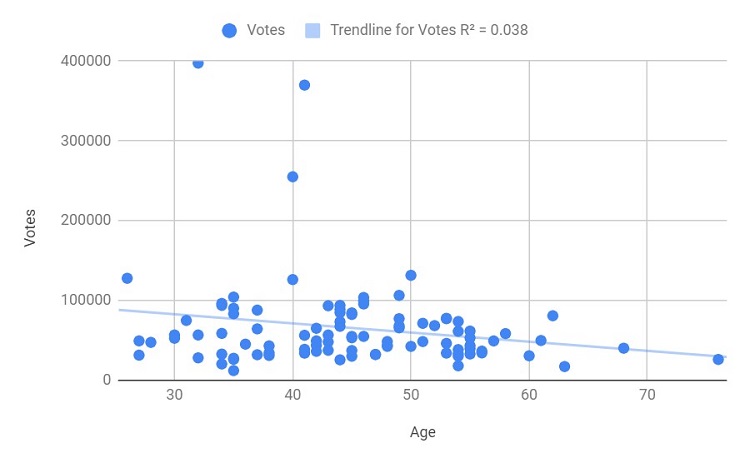
Finally, age is the last important variable. Female candidates are on average much younger than their male counterparts. In 2014, the mean age among elected female MPs was 44.64 years while males were on average 49.72 years old. In the 2014 campaign, each additional year decreased the odds of winning for women by 3.2 per cent. The following graph shows the trend line between age and votes among elected female candidates, highlighting that the biggest female vote getters were candidates under 45 years old. In contrast to their male counterparts, women aged over 45 struggled to win a large number of votes.
Against the background of this data, what should we make of the increase in female candidates for the 2019 elections? Unfortunately, there is little indication that female representation in parliament will improve markedly. While more women than ever will run for a seat in the DPR, most of these women will still appear on lower places on the ballot papers, just as in previous elections. The density plots below display how male candidates continue to enjoy the advantage of running as candidate #1, while women are mainly slotted in at number three and six, following the so-called zipper system.
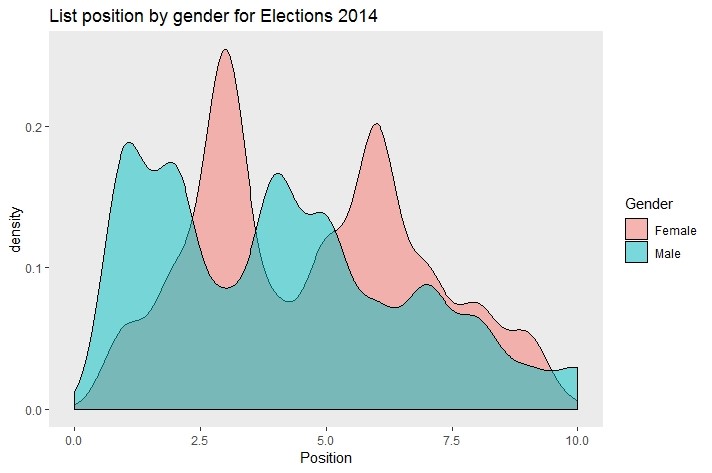
Figure. Density plots for list position based on gender in 2014
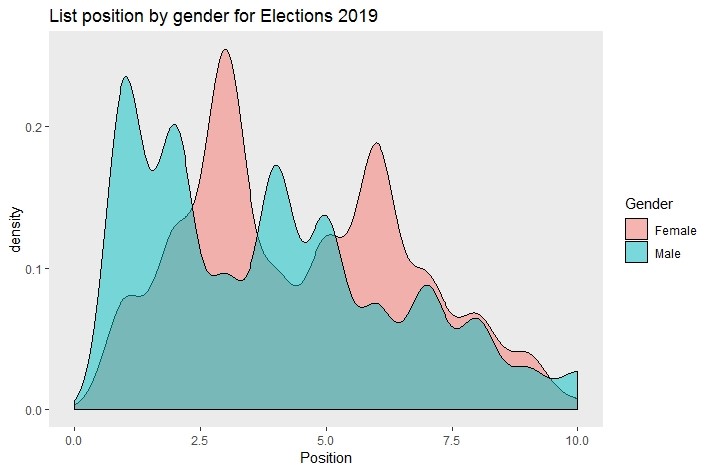
As this pattern of list positions for women mirrors previous elections, the number of elected female MPs is unlikely to change drastically in 2019. Hetifah Sjaifudian, an incumbent Golkar MP, predicts women’s results will be stagnant because there have been no significant changes to the nomination processes or to electoral regulations in regards to gender quotas. She further claims, ‘the hardest obstacle (for women to win) is the practice of money politics which is allegedly still massive even though the regulations are tougher now.’
Hetifah knows what she is talking about. Like other prominent female activists such as Eva Kusuma Sundari from PDIP, she failed to hold on to her DPR seat in the 2014 election, despite the advantage of incumbency. Both Hetifah and Eva later rejoined parliament when seats won by other candidates became vacant, but their joint experience of an unsuccessful campaign showed how difficult it is for activist candidates with limited financial resources to compete. Furthemore, there is a growing perception that many women who do succeed in getting elected are merely extensions of the political interests of their closest male relatives.
It is clear that the struggle to create a stronger voice for women’s interests in Indonesia must not stop with a quota system that simply pursues tokenistic electoral representation.
Ella S Prihatini (ella.prihatini@research.uwa.edu.au) is a PhD candidate in Political Science and International Relations at the University of Western Australia (UWA) and is affiliated with the UWA Public Policy Institute (UWAPPI).
Indonesian version here.
